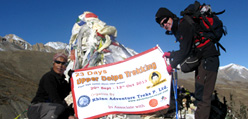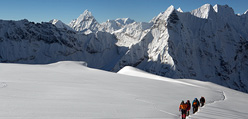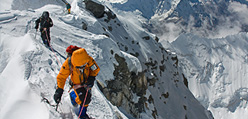Email : info@nepaltrekkingpackage.com
+977 - 01 - 4701300
Popular Packages
Nepal Expedition

With eight of the highest peaks in the world, Nepal has been the site of some of the most outstanding achievements in the field of mountain climbing. During many decades the dauntless peaks of ice and snow have offered challenges to those that dare. There are some 326 peaks in Nepal opened for mountaineering. In the past seven years alone the Government of Nepal has opened 175 peaks to celebrate the Mount Everest Golden Jubile.
Permission to climb a Himalayan peak in Nepal during the climbing season is issued by the Mountaineering Department of the Ministry of Tourism. For peaks Tibet, permission is issued by the China Tibet Mountaineering Association or by the Tibet Mountaineering Association. A number of documents are obligatory in either case. About 121 peaks in Nepal do not require the service of liaison officers during expeditions. The royalty depends on the height of the peak, season of the year and group size. The mountaineering teams must choose an agency with a proven record of being able to provide experienced Sherpa guides and Sherpa porters - the most important preconditions for achieving the goal in comfort and safety.
The Himalayas are the highest mountains of the world, and the Himalayas of Nepal are known as the roof of the world. These mountains take on an air of mystery from the time one enters them. Even today the wide zone of the Himalayas is intact. It always has been a source of fascination and inspiration to people from all walks of life in the world. The Himalayas are home to the snow and the gods. Its name has its roots in the Sanskrit language: him=snow, alaya= home. The Himalayas extend about 2,500 kilometres, twice as long as the Alps in Europe, and are about 300 km in width and rise to nine kilometres above sea level. The Brahamputra (Assam) in the east and the Indus in the west mark their end points.
The Himalayas of Nepal are located in the centre of the Himalayan range. Eight peaks of over 8,000 metres, including the world's highest peak, Mount Everest, are the most prominent members of this part of the range. There are some 1,310 magnificent summits of more than of 6,000 metres. They are literally what has put Nepal on the map. The country is also renowned for its friendly people and the traditional villages they still inhabit.
There once was a sea (the Tethys Sea) within the ancient continent of Gondwana (joining the Indian subcontinent and southern land masses). The Himalayas began to come into existence about 70 to 80 million years ago. The final uplift of the peaks began approximately 10 million years ago. Therefore, the Himalayas are still very young and geologically active. According to geologists, they are growing at a pace of 15 centimetres per year as the Indian plate moves north under the Euro-Asian plate. This ceaseless process of moving tectonic plates is what causes earthquakes in this region. The collision of the continents has resulted in sedimentary rocks that were once below the sea being brought to the surface. The granite formations of Mount Makalu and the metamorphic rocks in the lower layer of Mount Everest once lay under the Tethys Sea.
-

Mt. Ama Dablam Expedition
As the World knows that the region is of Mount Everest but Mount Ama Dabla is the dominant mountain due to its exposure above the valley to the east of Khumbu.
Read More -

Mt Baruntse Expedition
Mount Baruntse, 7120 metres above sea level, lies at, 27 52 19 longitude and 86 58 55 latitude, in the epicentre of three glacier valleys, the Imja, the Hunku and Barun.
Read More -

Mt Annapurna Expedition
Annapurna I, at a height of 8,091m, ranking the 10th tallest peak in the world, stands in the middle section of the Annapurna Himalayan Series with a latitude 28.53.37 and longitude 84.13.04.
Read More -

Mt. Kanchanjangha Expedition
Three of the five peaks (main, central, and south) are on the border of North Sikkim district of Sikkim, India and Taplejung District of Nepal, while the other two are completely in Taplejung District.
Read More -

Mt. Makalu Expedition
Mount Makalu is considered one of the most difficult mountains in the world to climb. The mountain is notorious for its steep pitches and knife-edged ridges involving a technical rock/ice climbing in the final ascent of the summit pyramid.
Read More -

Mt Lhotse Expedition
Lhotse is best known for its proximity to Mount Everest and it rises only 610 m above the South Col of Everest. Hence it is often seen as a minor eight-thousander...
Read More -

Mt. Manaslu Expedition
Mount Manaslu is the dominating peak in the Lamjung District and it stands to the rivalry of Mount Annapurna forty miles away to the east.
Read More -

Mt. Dhaulagiri Expedition
Mount Dhaulagiri is the seventh highest mountain in the world. It forms the eastern anchor of the Dhaulagiri Himal range, a sub-range of the Himalaya in the north central Nepal.
Read More -

Mt. cho-Oyu Expedition
Cho Oyu is the sixth highest mountain in the world at 8201 meters above sea level. Cho Oyu lies in the Himalayas and is 20 km west of Mount Everest, at the border between Tibet and Nepal above the famous Nangpa La (5,716m)
Read More -

Mt. Shishapangma Expedition
Shishasangma, at a height of 8,012m, ranking the 14th highest mountain in the world and the lowest of the eight-thousanders, is located at 85.70 east longitude and 28.30 north latitude stands....
Read More -

Mt Pumori Expedition
Most of the trekkers to Everest region attempt the top of Kalapathar, which is 5,545 meter above the sea level, for a better view of Mount Everest. The panorama from this view point includes...
Read More -

Mt. Lhakpa Expedition
This is one of the best programs for the climbers looking for an easy and +7000 meter peak in Himalaya. This program starts from Kathmandu. We fly to Lhasa where we will spend 3 nights visiting the main sanctuaries of Lhasa.
Read More


